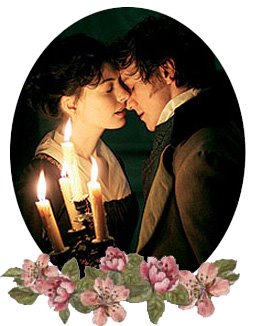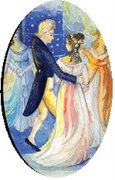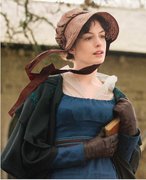Rice Portrait vs (and) Clarke’s Sketch
Last Sunday I discussed about James Stanier Clarke’s sketch of Jane Austen, which is asserted as authentic by several experts. When I was trying to insert the Rice picture just for another illustration, I accidentally placed it side by side with Clarke’s sketch. And…I was amazed by the similarities!
I understand that many people are sceptical about the authenticity of the Rice Portrait as the portrait of young Jane Austen. Because the Sunday post was about Clarke’s sketch, I didn’t want to write more about the Rice painting. But now, I think I can do that. I should refer the readers though, to the earlier post of Rice by Ms Place here, for it contains numerous information I used as the base for this article.
Now, the ‘Rice Portrait’ actually refers to a portrait of a young girl made by Ozias Humphry, a renowned English painter (1742-1810). Despite his fantastic works, Humphry’s eyesight was getting poorer and poorer, and in 1797 he was blind. Hence, if the Rice Portrait was indeed Humphry’s (as confirmed by Conal MacFarlane for Christie’s in New York), he must have painted it pre-1797. Experts suggest that the Rice Portrait was painted in 1788-1789, which makes sense in terms of Humphry’s life, for he still had his eyes functioning well at that time, and he had just arrived from India (he travelled in India 1785-1787).
What about the painting itself? Well, apparently the painting was owned by Francis Austen (Jane Austen’s great uncle). As he died, the old Francis Austen left his male descendants quite a few pounds (Revd George Austen was able to take his family on a seafront holiday)(Nokes 1997). However, he apparently did not leave anything for the female descendants. The painting later became the property of Col. Thomas Austen of Sevenoaks (Francis’ grandson and Jane’s cousin) who, after Jane’s death in 1817, gave away the painting as a wedding gift for Elizabeth ‘Lizzy’ Austen (daughter of Edward, Jane’s brother) who married Edward Rice of Dane Court (Faye et al. 1989). There was another woman that was married to Mr. Henry Rice (Edward Rice’s brother). This woman was Jemima-Lucy Lefroy, Mrs. Lefroy’s daughter (also the Lucy in Becoming Jane). But, I suppose, the one receiving this painting would be Lizzy Rice (though it’s interesting that an Austen and a Lefroy were once more united, this time as sisters-in-law). The painting is now owned by her descendant, also named Henry Rice. He believes, of course, that the painting is of Jane Austen, but apparently that is not the case with the rest of the Austenites, for opinions are split.
Arguments supporting the painting as the young Austen include the popularity of green umbrellas in the 1788s (around the time the painting was taken). In addition, famous costume collectors Lillian and Ted Williams said as followed:
‘Having carefully examined the actual portrait, as opposed to its reproduction, we find several elements that clearly suggest an eighteenth century dating starting in the late 1780s. We ourselves have owned several eighteenth-century gowns similar to the one pictured in the Rice Portrait. In the Rice Portrait, we note the fullness of the cut of the dress with substantial distribution of its fabric around the bodice rather than trained in the rear in the later Empire style.
Furthermore, the gauze gathered around the neckline - which is not discernible in many photographic reproductions - is consistent with late 18th century garniture. Finally, the shoes and certainly the parasol with its fringe of cut green silk is consistent with the same period. As far as dating is concerned, the width of the ribbon at the bodice is of no consequence one way or the other in our view.’
Jack Malvern of Times also added some facts that Jane Austen inserted the reference of muslins in her earlier work of Northanger Abbey (though it was published post-humous) and Mansfield Park, and that Marianne Dashwood (Sense & Sensibility) wore a locket that contained the picture of her late uncle (father?) who (like Francis Austen) left the Dashwood sisters next to nothing.
Those who are against the notion that the Rice Portrait was actually a painting of Jane Austen mainly disagreed about the costume (e.g., my dearest
To my non-expert eyes (which have dwelled in Regency costumes for a while now), young Miss Willoughby’s dress looks like the young girl in Rice Portrait. According to Wikipedia, Miss Willoughby ‘wears the loose, sashed white gown that is the English girl's equivalent of the fashionable lady's chemise dress’. Ted and Lillian Williams said that ‘As far as dating is concerned, the width of the ribbon at the bodice is of no consequence one way or the other in our view.’ Hence, I think it’s possible that the young girl in Rice Portrait was indeed painted pre 1790.
But, if the painting is true the painting of young Jane Austen, why was the Rice Portrait never mentioned in the Austen family record? Well, Henry Rice pointed out that the portrait of Edward Austen exists, although it is never mentioned. Plus, apparently the rich Uncle Francis Austen left nothing to the poorer branch of the Austen family (a fact that Jane secretly criticised in Sense & Sensibility), hence the mentioning of Francus Austen might be a ‘taboo’ to Jane’s family.
I am inclined to say that the Rice Portrait is actually the portrait of young Jane Austen as a teenager (about 13-14 years). Yet, despite many interests and suggestions of the portrait’s originality, doubts managed to cancel the auction of Rice Portrait in Christie’s this April, and hence the painting remains in
I think, if many experts and forensics can be recruited to scrutinise Clarke’s sketch (and come up with an agreement that the lady in Clarke’s sketch was indeed Jane Austen), why can’t it be done for Rice Portrait? As far as I know, such forensic has never been conducted extensively. Henry Rice, who is the still-living relative of Jane Austen, has his commitment to prove the validity of the painting. Besides, Rice Portrait has been in the family for more than 200 years. After all, I think Jane’s family must be confident enough that the young girl in the painting was indeed Jane Austen before giving the painting to Rice.
Reference:
Faye, D. l., Austen-Leigh, W. & Austen-Leigh, R. A. 1989, Jane Austen: A Family Record, The British Library, London.
Nokes, D. 1997, Jane Austen: A Life, Fourth Estate, London.
Pic1a: James Stanier Clarke's sketch of Jane Austen (1815)
Pic 1b: The Rice Portrait (c1788/89)
Pci 2: The Rice Portrait at Christie's, from Reuters
Pic 3: Miss Willoughby, from Wikipedia
















































1 comment:
Hello,
Such an interesting controversy. It is acknowledge in the history of fashion that children's costume fashion pre-figures adult fashion by some years. Almost as if they tried it out on the children first!When the first objection was made on the grounds of fashion, this was not known, nor where the many examples evidencing that this was in fact an existing fashion acknowledged. Inexplicably, it is still not acknowledged by some.
Post a Comment